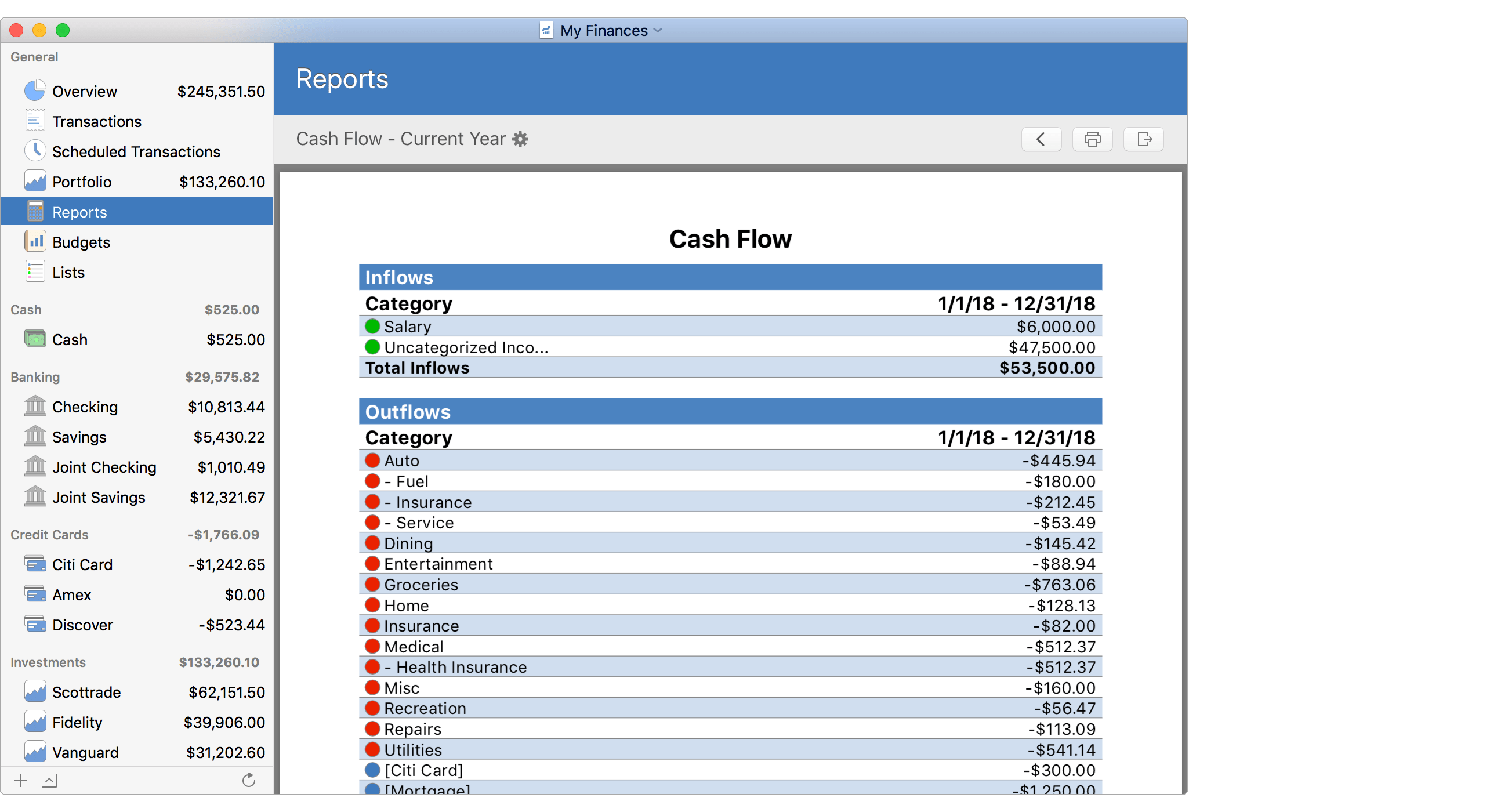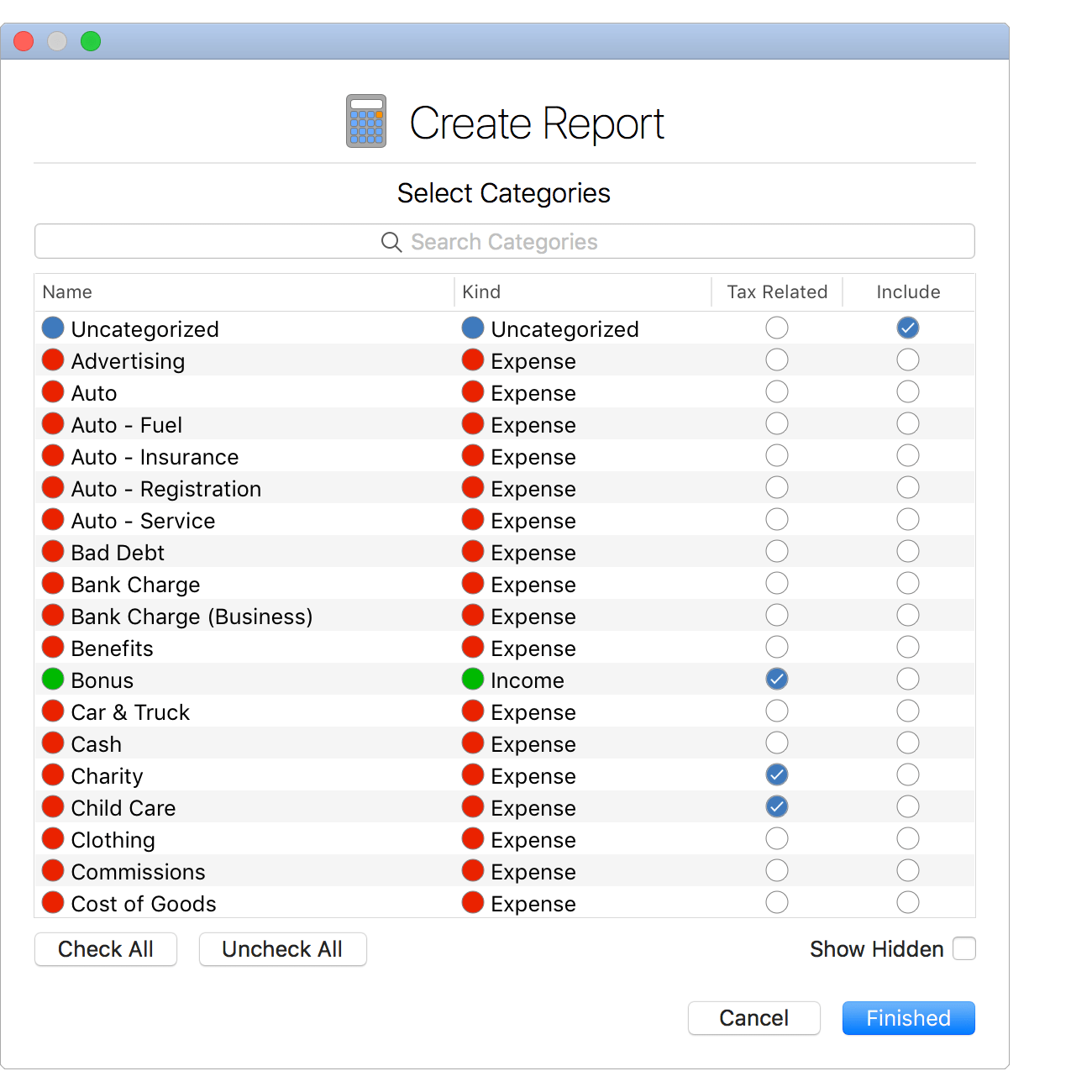Cash Flow reports can be used to reference cash inflows and outflows by category for any date range. Learn more about how to setup Cash Flow reports below.

![]() Note:
Totals for "parent" categories, categories with subcategories, will include the values for their subcategories.
However, the amounts will not be double counted in the overall totals for the report.
Note:
Totals for "parent" categories, categories with subcategories, will include the values for their subcategories.
However, the amounts will not be double counted in the overall totals for the report.
Cash Flow report setup
Edit the general settings for the report as desired and then select to "Continue" or to be "Finished" setting up the report depending if you have chosen to select specific accounts or categories for the report.

General settings:
- Name: The name to display for the report. Shown for the report's heading and in the list of reports.
- Date Period: The date range for the report. Select "Custom Date Range" to pick a specific date range or use one of the available date ranges such as "Current Year".
- Start: The starting date for the report's date range.
- End: The ending date for the report's date range.
- Date Intervals: The intervals to report within the date range. For example, a "Monthly" date interval for a report starting on the first of the year and ending on the last of the year will display information for every month.
- Format: How the report will be structured. Format options include: "Categories" (inflows and outflows by category), "Categories with Transactions" (inflows and outflows by category while listing the transactions for each category), and "Transactions Only" (lists of inflow and outflow transactions that met the report's parameters).
- Accounts: The accounts that will be included: "Specific Accounts", "All Accounts", or "All Taxable Accounts". You will be presented with the option to select the accounts in an additional step if "Specific Accounts" is chosen.
- Categories: The categories that will be included: "Specific Categories", "All Categories", "All Income Categories", "All Expense Categories", "All Tax Related Categories", "All Tax Related Income Categories", or "All Tax Related Expense Categories". You will be presented with the option to select the accounts in an additional step if "Specific Categories" is chosen.
- Transfers: Whether or not account transfers are included. Options include: "All Transfers", "Don't Include Transfers" or "Include Transfers with Excluded Accounts". Transactions will be considered a transfer if its category is set to an account category or if it uses the "Transfer" transaction type.
- Status: Limit the transactions that can be included based on their status. For example, exclude transactions marked as "Pending" by using the "Non-Pending" option.
- Currency: The currency for the report's totals.
![]() Note:
Transaction amounts will be listed in their account's native currency.
All other listed currency amounts will be in the report's currency.
Note:
Transaction amounts will be listed in their account's native currency.
All other listed currency amounts will be in the report's currency.
Select specific accounts:
If you chose the option to "Specify Accounts", mark which accounts to "Include" in the report as desired and then select to "Continue" or to be "Finished" setting up the report depending if you have chosen to select specific categories for the report.

![]() Tip:
Use multiple selection and press the spacebar to toggle the "Include" checkboxes on/off.
Check the "Show Hidden" option to display accounts not marked to be included in reports.
Tip:
Use multiple selection and press the spacebar to toggle the "Include" checkboxes on/off.
Check the "Show Hidden" option to display accounts not marked to be included in reports.
Select specific categories:
If you chose the option to "Specify Categories", mark which categories to "Include" in the report as desired and then select to be "Finished" setting up the report.

![]() Tip:
Use multiple selection and press the spacebar to toggle the "Include" checkboxes on/off.
Check the "Show Hidden" option to display categories not marked to be included in reports.
Tip:
Use multiple selection and press the spacebar to toggle the "Include" checkboxes on/off.
Check the "Show Hidden" option to display categories not marked to be included in reports.
![]() Note:
The "Uncategorized", "Uncategorized Income" and "Uncategorized Expense" options can be used to capture the transactions that are not listed with a category.
The "Other Categories", "Other Income Categories" and "Other Expense Categories" options can be used to capture the transactions listed with categories that are not included in the report.
Note:
The "Uncategorized", "Uncategorized Income" and "Uncategorized Expense" options can be used to capture the transactions that are not listed with a category.
The "Other Categories", "Other Income Categories" and "Other Expense Categories" options can be used to capture the transactions listed with categories that are not included in the report.